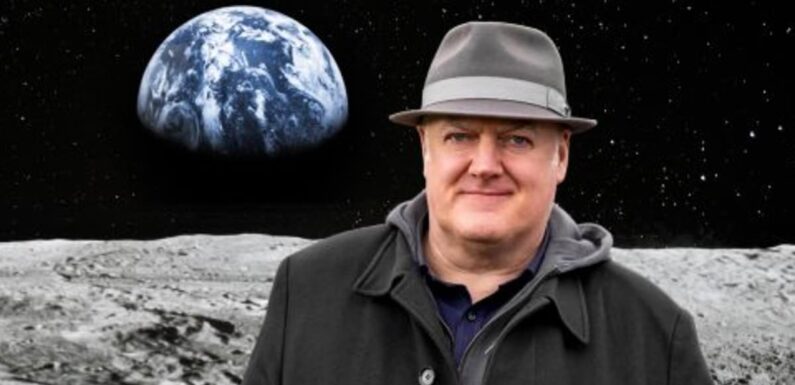
Mysteries of the moon explained: A fascinating new series reveals how it’s shaped the past… and will have a huge impact on our future
- Dara O Briain examines the mysteries about Earth’s only natural satellite
- READ MORE: Adoptee Dara O’Briain says Dame Judi Dench inspired him to launch search for his birth mother
Some howl at it, others believe it can stop them sleeping. Animals use it as a navigational tool, and without it there would be no human race.
Yet few people realise just how important the Moon is.
Now, fascinating new Ch5 show Wonders Of The Moon, hosted by comic and amateur astronomer Dara O Briain, examines the mysteries and myths about Earth’s only natural satellite, and the way it shapes who we are and our world.
‘I love everything about space but the Moon holds a special kind of magic,’ says former Stargazing Live presenter Dara.
‘Without it we wouldn’t be here. It’s profoundly shaped our culture and inspired one of our greatest achievements.’
Wonders Of The Moon, hosted by comic and amateur astronomer Dara O Briain, examines the mysteries and myths about Earth’s only natural satellite, and the way it shapes who we are and our world. Dara – and Earth as seen from the Moon
And, as he finds out in the two-part series, new things are still being discovered about the Moon that could shape our future as well as illuminate our past.
The show starts at Newgrange in Ireland, a 5,000-year-old man-made mound with the remains of a circle of standing stones. It functioned as a solar calendar, but new research suggests it was also one of the first lunar calendars.
The word month comes from moon, and a lunar calendar could have helped farmers learn when it was best to sow seed and harvest crops, with the year’s progress determined by the wax and wane of the Moon.
Dara also travels to Kent to speak to astrobiologist Professor Lewis Dartnell to discover how the Moon’s influence on life on Earth goes back much further in time, because it produces tides in our seas as a result of its gravitational pull.
When the Moon was closer to us (it’s moving away from Earth at a rate of around 3.8cm a year), tides were more extreme, meaning many sea animals had to work out how to survive on land, thus paving the way for humans.
‘The tidal effect meant animals were given practice at walking on land before the sea came back and they got wet again,’ says Professor Dartnell. ‘Eventually there was this evolutionary drive to walk on land so they could get from a small tidal pool to a bigger one and so survive before drying out.’
How big an impact the Moon still has on humans is debatable, but its impact on other creatures is clear. Dara meets a farmer in Cornwall to find out why cows are more fertile at a full moon, and learns from a fisherman how tides affect where fish populations thrive.
But while it’s been proved that humans do sleep less when there’s a full moon, Dara discovers the idea it can affect menstruation or even crime rates is little more than ‘pseudo-science’.
Pictured: New research suggests that Ireland’s Newgrange site was one of the first-ever lunar calendars
The series also examines our growing knowledge about the surface of the Moon itself, with new research on rocks collected on previous moon landings finding evidence of water on what had been thought to be a dry, arid surface.
Dara also hears about plans for the use of machines on the Moon’s surface that might find enough water to support life.
Also, because the Moon has much less gravity than Earth, rockets could be launched to Mars from the lunar surface.
‘I’m genuinely excited to know what that is going to do for people’s imaginations,’ says Dara, who says learning about the moon landings ignited his passion for astronomy.
‘To point at the Moon and be able to say, ‘There are people up there now’, that is going to be a huge thing.’
Wonders Of The Moon With Dara O Briain, Tuesday & Wednesday, 9pm, Channel 5.
Source: Read Full Article

